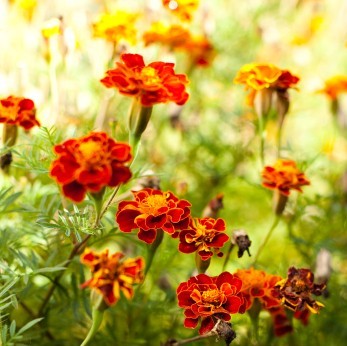
Some garden experts feel that we rely too much on marigolds to fill in our summer beds and borders. I disagree. If anything, these summer staples are often under appreciated. Marigolds couldn't be any easier to grow, and their cheerful flowers offer a summer-long burst of color anywhere you plant them.
Origins: Mexico, Central and South America.
Life cycle: Half-hardy annual.
Site: Full sun to partial shade (better in sun).
Soil: Average, well-drained soil.
Height: Dwarf, 6 to 12 inches; large, 18 to 36 inches tall.
Foliage: Dark green leaves are thin and lacy; pungent when crushed.
Flowers: Yellow, maroon, orange, creamy white, or bi-colored; flowering from June-October.
Watering: Plants are drought tolerant, but perform better with regular watering.
Propagation: Sow seed indoors in mid-spring or outdoors after danger of frost has passed.
Garden uses: Container planting, cut-flower garden edging, mass planting, mixed borders, rock garden.
African marigolds (T. erecta): This is the largest variety, growing 1 1/2 to 3 feet tall with tight double pompom blooms (white, gold, or orange) that are 4 to 5 inches wide. Compact cultivars stay under 18 inches. These are the strongest smelling of all marigolds, but the odor is only emitted if you crush the leaves or stick your nose in the flower.
French marigolds (T. patula): Mid-size plants grow 6 to 18 inches tall and have 1 to 2 inch wide more open flowers (single, semi-double, or double). The flowers are often bi-colored.
Triploid marigolds (T. erecta x patula): These hybrids are a cross between French and African marigolds and grow to a height of 12 inches tall. Because they are sterile, none of their energy goes into seed production which results in vigorous 2 to 3 inch wide flowers. Triploids will keep blooming even in hot weather.
Signet marigolds (T. tenuifolia): Plants form mounds of flowers, 9 to 12 inches tall, with lacy foliage and masses of 3/4 to 1 inch ray-like flowers. The blooms are edible.
Marigolds offer months of easy-care color and combine well with other annuals and perennials in the flower garden. Compact signet marigolds and the mid-sized French types are well-suited to edgings, walkways, and mixed containers. The taller African marigolds are best for back borders and cutting gardens.
Marigolds also make good neighbors in the vegetable garden. Many long-time gardeners claim the roots of marigolds discourage nematodes when planted near tomatoes, potatoes, asparagus, strawberries, and roses. Their flower petals are rumored to repel the Mexican bean beetle when planted around bean plants. While there is no concrete scientific evidence to back up these claims, marigolds are still worthy of some planting space. They attract hover flies, which attack aphids, and their bright and cheerful appearance is sure to make any garden a more pleasant place.

About The Author: Ellen Brown is an environmental writer and photographer and the owner of Sustainable Media, an environmental media company that specializes in helping businesses and organizations promote eco-friendly products and services. Contact her on the web at http://www.sustainable-media.com
Add your voice! Click below to comment. ThriftyFun is powered by your wisdom!
I also love to plant Marigolds. Their colors are so bright. I have also found that they thrive in soil where no other plants will thrive. I have been planting them for years(over 20) We live in the country in WV and they are one of the few that the deer wont eat!
I love Marigolds! They give you a lot of bang for the little time & effort you have to put into them. I love them so much that my 13 year old beagle is named Marigold.
God Bless.
Trish in CT

Add your voice! Click below to comment. ThriftyFun is powered by your wisdom!